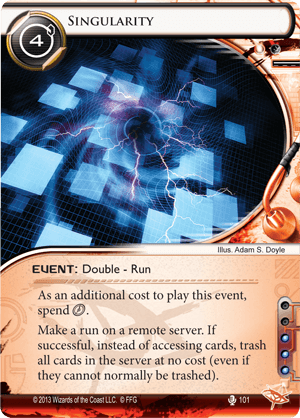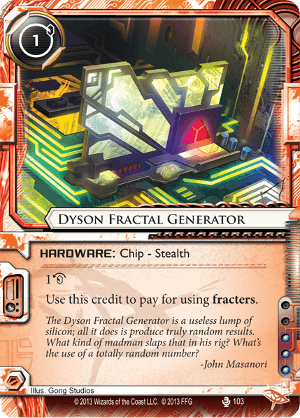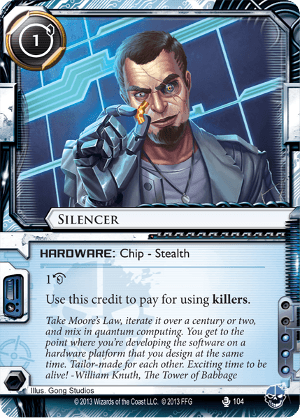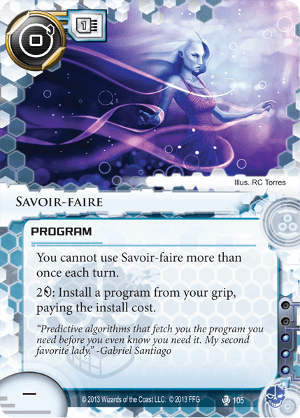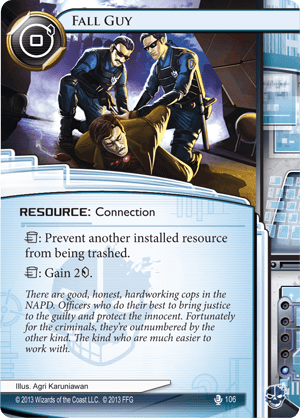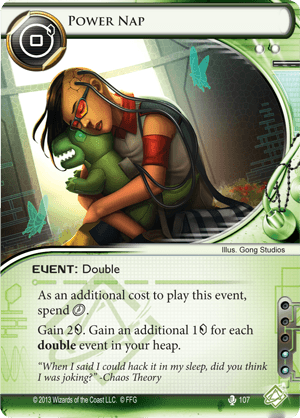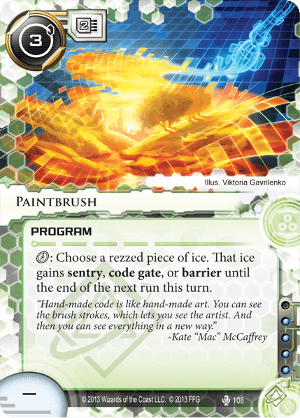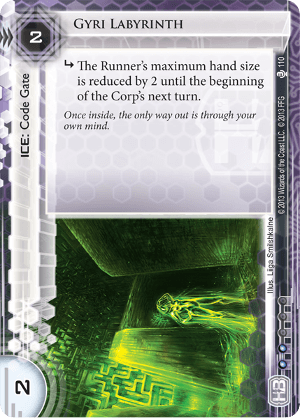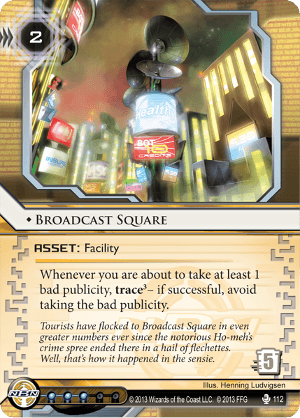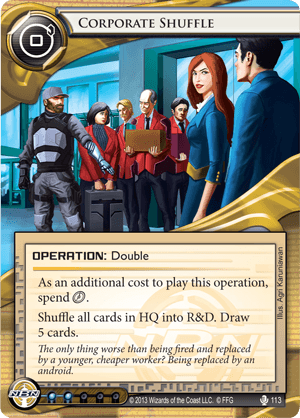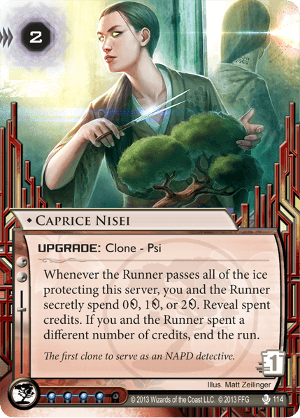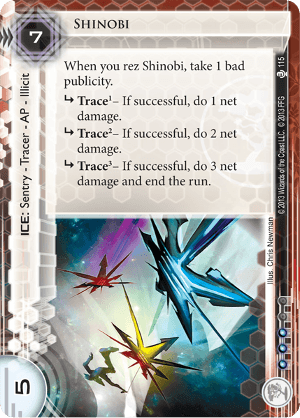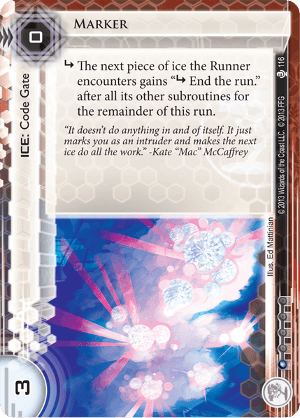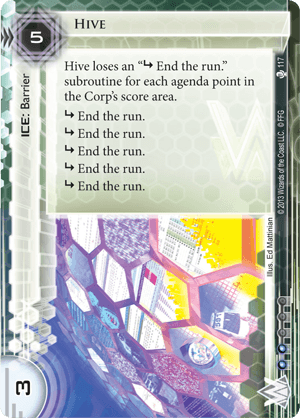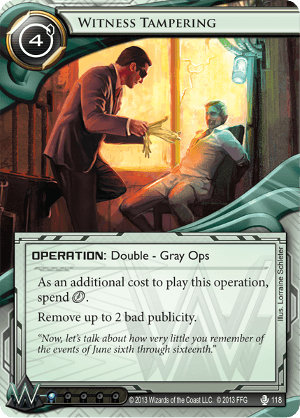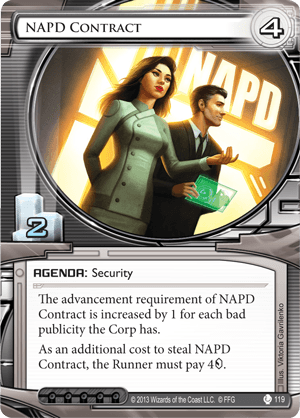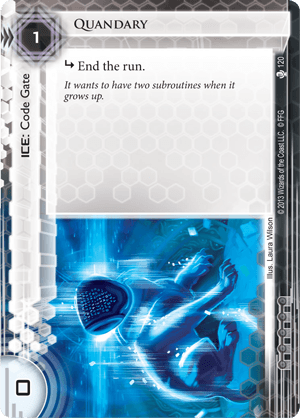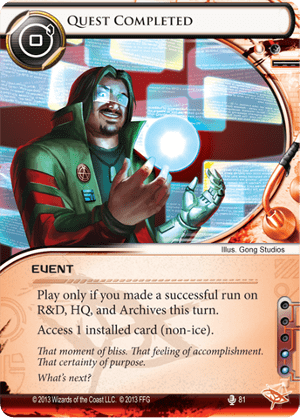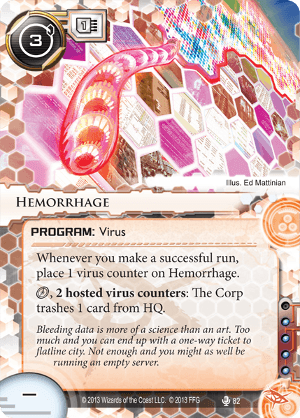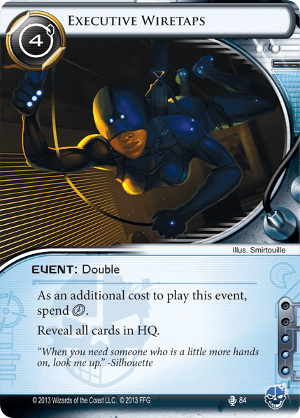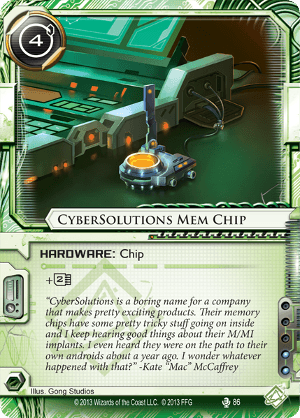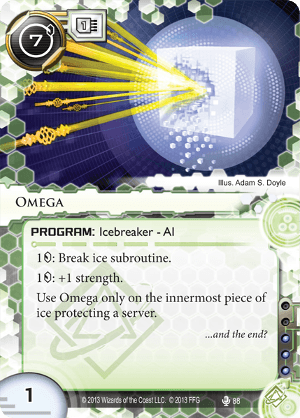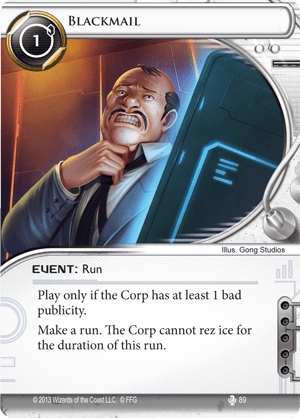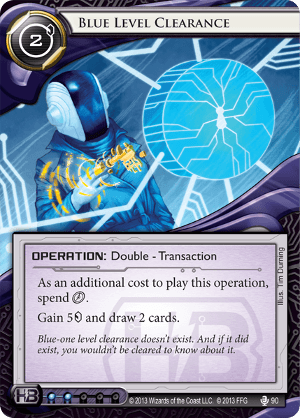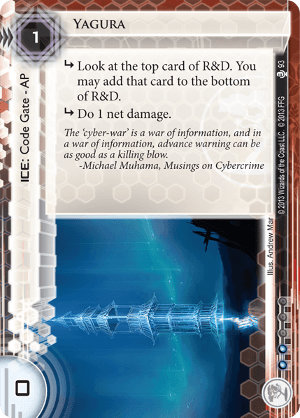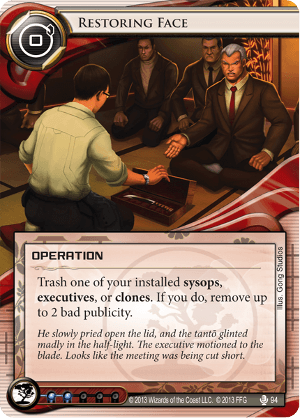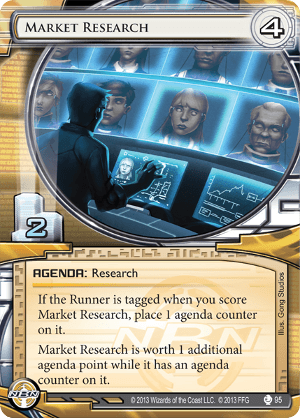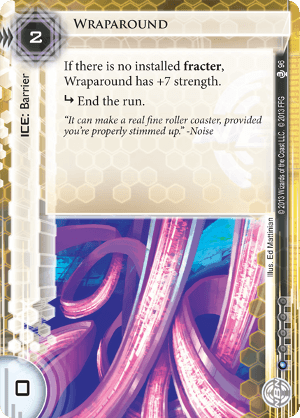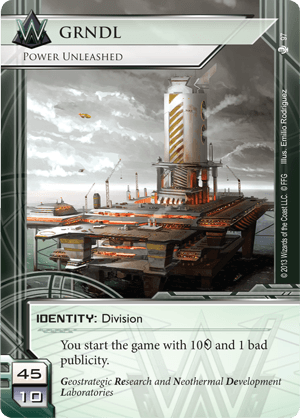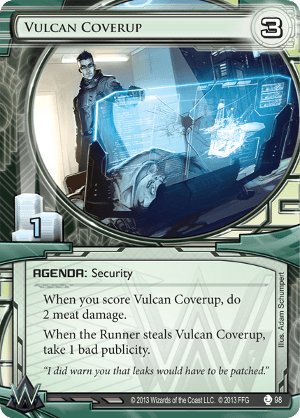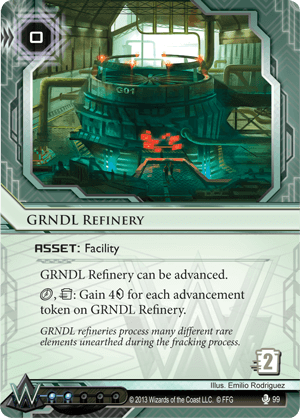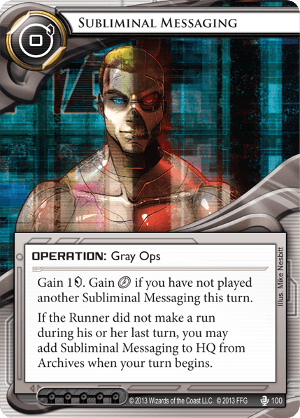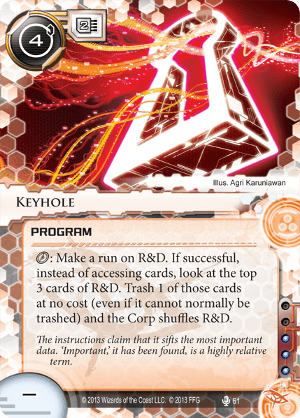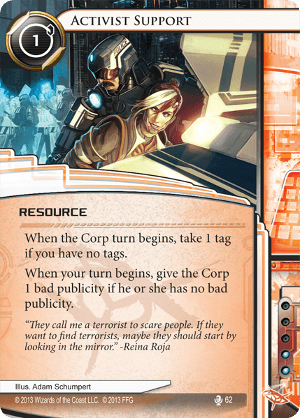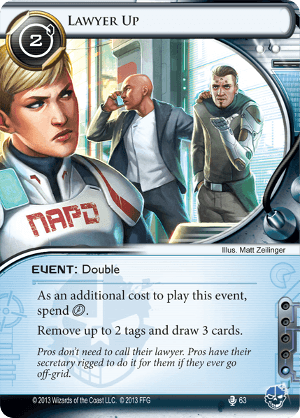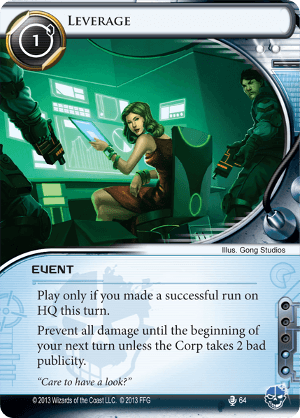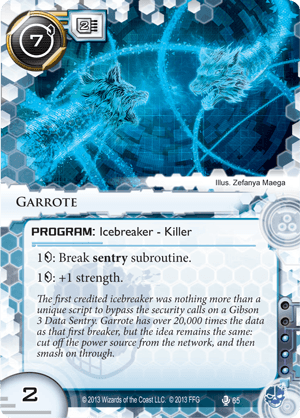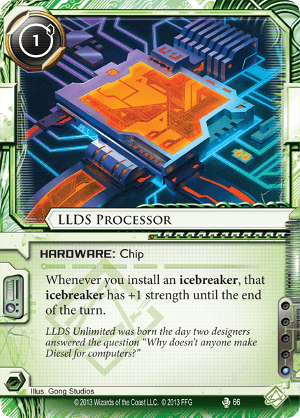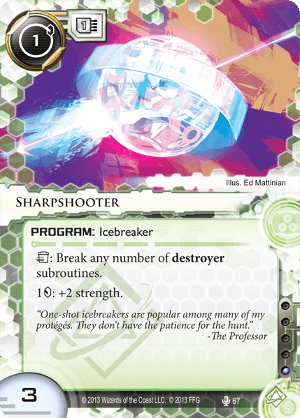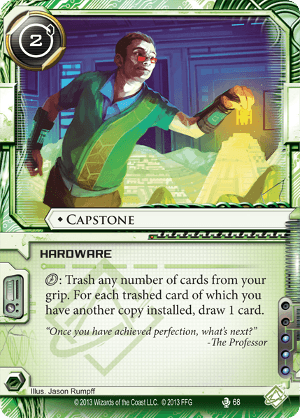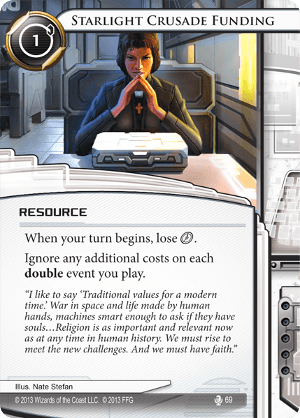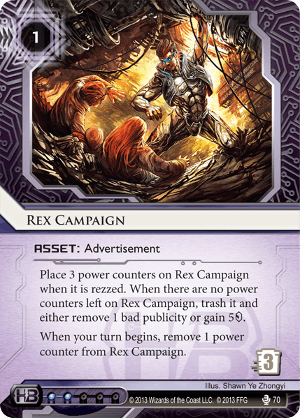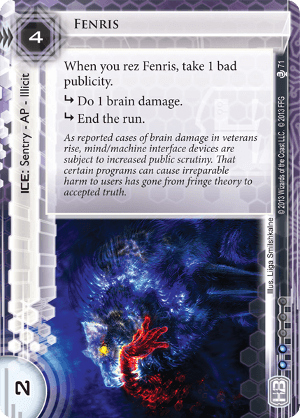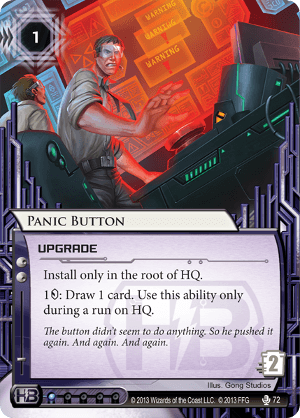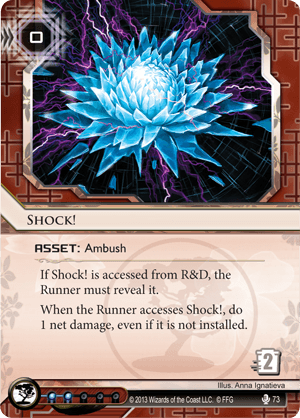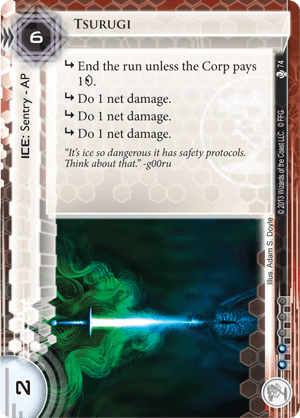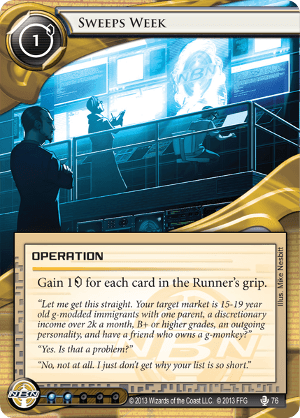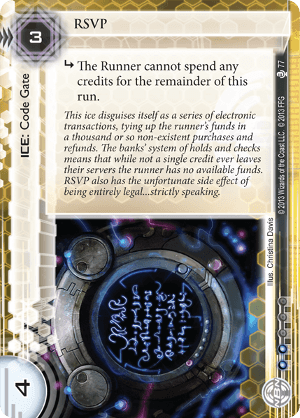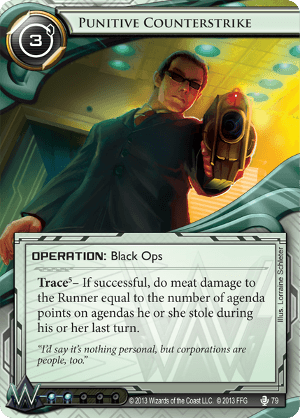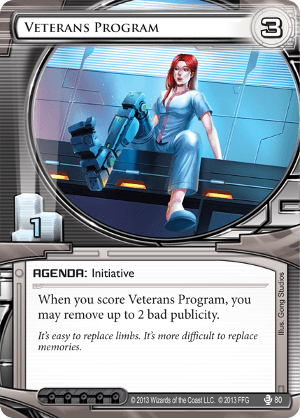The insert for Double Time, the final pack in the Spin Cycle, brings a close to the story. It is framed as a display of a chat program, with several people (presumably runners) discussing the capture of Reina Roja. Although -wingman- is almost certainly John Masanori and dinomyte could be Chaos Theory, there are not quite enough clues to figure out who dontmakeme and prowler_32 are. They touch on the possibility that Reina allowed herself to be captured as part of a ploy to take out the kidnappers, but nothing is very certain. For now, we shall move on from the story to the cards in this set.
Singularity
So perhaps the corporation has set up cards in a server, and you are not quite certain whether it is a trap or an agenda. Well, with this card, you can make a run on a remote server, and if it is successful, you can trash all the cards installed in the server at no cost. Of course, this does cost you 4 credits and 2 clicks, and you will likely have to spend credits to get into the server if there is ice in the way. However, if the corporation is using multiple upgrades in one server, this could be a cheaper way to get rid of them all at once without the risk of hitting any traps.
Pair cards: Ken "Express" Tenma: Disappeared Clone, Planned Assault, Public Terminal
Queen's Gambit
With this card, you can spend 2 clicks to gain up to 6 credits, equivalent to playing 2 copies of Easy Mark. However, in order to do so, you have to place up to 3 advancement counters on an unrezzed card in a remote server. Ideally, you would want to place those advancement tokens on a card that is not an agenda, because the rest of the card says you are not allowed to access that card this turn. Of course, using expose effects might tip your hand to the corporation that you are setting up for this. Or they may just think you are trying to figure out where their agendas are, so they may not spend resource rezzing their cards to deny you some cash. Either way, playing the Queen's Gambit could benefit you.
Trivia: The Queen's Gambit is one of the earliest known chess openings. It covers three moves from the start of the game: White advances the queen's pawn 2 spaces, Black advances the queen's pawn 2 spaces, and White advances the queen's bishop's pawn 2 spaces. From here, the game can progress into either Queen's Gambit Accepted, where Black takes the queen's bishop's pawn, or Queen's Gambit Declined, where Black does not take the pawn.
Pair cards: Infiltration, Starlight Crusade Funding, Power Nap
Dyson Fractal Generator
We now have the Anarch equivalent of Lockpick. This card costs 1 to install and provides 1 recurring credit that can be spent on using fracters. It is also a stealth source, so it works with icebreakers that specifically require credits from stealth sources. The drawback is that the influence cost, as 3 copies of this will take up 9 influence outside of Anarch, typically leaving only 6 influence remaining. But, if you need the stealth credits or think you will be spending a lot on fracters, it may not be a bad idea to take this card.
Pair cards: Replicator, BlacKat, Blackstone
Silencer
And now, the Criminal equivalent of Lockpick. For 1 credit, you gain 1 recurring credit that can be spent on using killers. This feels a bit more useful, as breaking sentries can cost a lot of credits. But it is much more important with the killers that specifically require stealth credits. As such, if you intend to use them, you may want to put 2 or 3 copies of this into your deck.
Trivia: Sort of a reprint. From the Netrunner CCG, we have Corolla Speed Chip, which has the exact same cost and function as Silencer, but is not a stealth source.
Pair cards: Replicator, Dagger, Switchblade, Fawkes
Savoir-faire
Sort of the Criminal equivalent of Self-modifying Code. When installed, by spending 2 credits, you can install a program from your hand, paying its install cost. Primarily, you would use this ability during a run when you would otherwise be unable to install programs, or potentially during the corporation's turn. So why use this over Self-Modifying Code? Well, if you are already playing Criminal, it is in faction, so you can spend your influence on other cards. Also, this program only takes up 1 memory, as opposed to the 2 required for Self-Modifying Code. Finally, this installs from your hand as opposed to from the deck, so if your programs are in hand, then Self-Modifying Code does not help as much. Of course, you can only use Savoir-Faire once each turn, which could be another benefit above Self-Modifying Code, as you can use it more than once.
Trivia: Savoir-faire is a French noun phrase that means being adaptable and adroit. Also, Savoir-faire Linux is a French Canadian company specializing in open source software and digital electronics.
Pair cards: Special Order, Sahasrara, Golden, Peregrine, Saker
Fall Guy
This card primarily exists to protect your other resources. While it is in play, you can trash it to prevent another installed resource from being trashed. Of course, just one copy may not be enough to prevent the corporation from spending 2 more credits and another click to trash your resource again, so having multiple copies installed is a great idea. Plus, if you ever need a quick boost of cash, you can trash one to gain 2 credits. All around, a very solid card.
Trivia: I have mentioned before that the Netrunner CCG does have a card named Fall Guy, but it is an early version of Decoy. This card comes closer to a combination of two hidden resources from the Proteus expansion: Swiss Bank Account which can be trashed to gain 2 credits for paying a cost or penalty, and Time to Collect, which can prevent one or more other resources from being trashed.
Pair cards: Hostage, Calling in Favors, Off-Campus Apartment, Armand "Geist" Walker: Tech Lord, Tech Trader
Power Nap
If you are already playing a lot of double events, here is one you should consider adding. You gain 2 credits when you play this, which is not great, considering it is the equivalent of spending a click for a credit twice. However, you gain an additional credit for each double even in your discard pile, which can start adding up if you have played several double events already. Note that because events are not added to your discard pile until they resolve, you can not count the copy of Power Nap currently being played as one in your heap, so make sure there are some double events already there before you use this.
Pair cards: double events, Starlight Crusade Funding, Comet
Paintbrush
An interesting program. With this installed, you can give a rezzed piece of ice the sentry, code gate, or barrier keyword until the end of the next run or the turn, whichever comes first. That way, you could break a piece of ice with the breaker you already have installed instead of having to dig through your deck for the one that matches its type. Or you could use a slightly more efficient icebreaker, making it cheaper to break a specific piece of ice. The drawback is that, unlike Tinkering, the ice must already be rezzed, so you may have to face check some ice, which could be very dangerous. Also, this program takes up 2 memory, so you may need some memory chips or a console to get the rest of your rig out.
Pair cards: Forged Activation Orders, Blackguard
Lucky Find
Sort of a bigger version of Sure Gamble. With this card, you only need to spend 3 credits to go up to 9 credits, netting you a gain of 6 credits. Of course, it does take an extra click to play, so you will have less time for other actions. Also, this is a neutral card with an influence cost, so putting this into your deck will mean having to take fewer cards from other factions. But, it could be worth it for the sheer boost of credits.
Trivia: This card is a reprint. From the Classic expansion to the Netrunner CCG, we have Networking, which has the exact same play cost and effect as Lucky Find, and is also a double event.
Pair cards: Prepaid VoicePAD, Starlight Crusade Funding, Power Nap, Comet
Gyri Labyrinth
This card is interesting. It is a code gate that does not stop the runner, but if the runner can not break it, then their maximum hand size will be reduced until the beginning of the corporation's next turn. Because of this, if they hit one of these, they may have to discard two cards at the end of the turn, potentially setting them up for an easy kill. The downside is that unless the runner is very aggressive, you may not get to trigger this effect more than once, and may not get to use it at all. Although, if you could force them to run into several at a time when they could do nothing about it, you could potentially reduce their maximum hand size below zero, which would make them lose at the end of their next turn.
Pair cards: Chairman Hiro, An Offer You Can't Refuse, Bio-Ethics Association
Reclamation Order
Another card that has enabled massive combo decks. With this card, you can spend 2 clicks and 1 credit to name a card that is not Reclamation Order. Then, you can reveal any number of copies of that card that are in your discard pile and add them back to your hand. This allows you to get back the operations you have already used so you can set them up again for another combo, or just to play them over and over again.
Pair cards: Cerebral Imaging: Infinite Frontiers, Accelerated Diagnostics, Hasty Relocation
Broadcast Square
Sort of a preventative measure against bad publicity. This asset costs 2 to rez and 5 to trash, but while rezzed, whenever you would take at least 1 bad publicity, you start a trace with a base strength of 3. If the trace is successful, you avoid taking the bad publicity. So if your deck has multiple illicit cards in it, then you could gain the benefits of those cards without the penalty of bad publicity. Of course, you will probably have to invest some resources into the trace, and if the runner has gone with high link strength, then there is little that you can do. Just do not use this with Profiteering, as if you avoid the bad publicity from that card, you do not gain any money.
Trivia: Broadcast Square is a location in the Android board game. While there, an investigator can spend 1 time unit and 1 favor of any type to place one of the conspiracy puzzle pieces onto the conspiracy board. Normally, to place a conspiracy piece, you would have to investigate a piece of evidence and choose to unravel the conspiracy, which would allow you to place a piece from the stack your token is next to. But this ability allows you to place a puzzle piece from any of the stacks available.
Pair cards: illicit cards, NBN: Making News, Primary Transmission Dish
Corporate Shuffle
So perhaps your hand is filled with agenda cards. Normally, you would have to hope that the runner does not run on your hand. But with this card, you can shuffle all the cards in your hand back into your deck. Then, you draw 5 new cards. This could put you in a much better position. Of course, the possibility exists that your new hand is also full of agenda cards, but that is always a risk in drawing cards. Or if you have no other cards in hand, you could use this to shuffle your deck and draw 5 new cards. It does take 2 clicks to do so, but getting a new hand of cards could drastically improve your options.
Trivia: Another reprint here. From the Classic expansion to the Netrunner CCG, we have Corporate Shuffle, which lets you draw 5 cards, then shuffle a card in your hand back into your deck.
Pair cards: anything
Caprice Nisei
Ah Caprice. Potentially amazing for the corporation and frustrating for the runner. While Caprice is rezzed, once the runner passes all of the ice on the server, you then each secretly spend 0, 1, or 2 credits. If you spent a different amount of credits, then the run immediately ends. As such, Caprice makes for a great extra line of defense on any server, as long as you can keep your credits up. Also, Caprice must be rezzed before the runner passes the last piece of ice, so you will want to rez her when the runner is approaching that last piece of ice, or possibly before. Still, there are a number of ways the runner can deal with her, and her low trash cost means that the runner will almost certainly trash her if they access her. So it would be a good idea to give her a layer of protection as well.
Trivia: Caprice Nisei is one of the five playable detectives in the Android board game. Her psychic abilities and her access to the resources of Jinteki give her a unique way of handling the murder investigation. However, her powers may be mentally unbalancing to her, and she will have to be careful to maintain her grip on reality, or else the Nisei project may be shut down, resulting in the "retirement" of her and her sisters.
Caprice is also a minor character in the novel Strange Flesh, by Matthew Farrer, and the novella Exodus, by Lisa Farrel. In Strange Flesh, she is conducting the interview with Tallie Perrault, examining her memories of the events. In Exodus, she is simultaneous investigating the murder of a known runner for the NAPD while working on hunting down the rogue clone Ken Tenma in order to retrieve the clone he has stolen.
Pair cards: Ash 2X3ZB9CY, Nisei Division: The Next Generation, Marcus Batty, Hyoubu Research Facility
Shinobi
And finally, a piece of illicit ice for Jinteki. With 3 subroutines, this sentry could be expensive for the runner to break, but they may be more likely to let the subroutines fire. Each subroutine starts a trace with a base strength of 1, 2, or 3. If the trace is successful, then you do net damage to the runner equal to the base strength of the trace, and in the case of the third subroutine, end the run. So the runner may spend credits to break the last subroutine, since it is the only one that can actually stop them, and may soak up the damage or try to dodge the trace. Also, the bad publicity could be used in future runs against this ice. As such, you will likely want to remove that bad publicity to make effective use of this ice.
Trivia: Shinobi is a Japanese word for a covert agent, and may be synonymous with ninja.
Pair cards: Clone Retirement, Primary Transmission Dish, Improved Tracers
Marker
A card that could have potential, depending on how your opponent has set up their rig. This code gate is free to rez, but does not stop the runner. Instead, its one subroutine grants the next piece of ice encountered an additional "end the run" subroutine after all of its other subroutines. If the runner is using an icebreaker that costs several credits to break up to a certain number of subroutines, that extra subroutine could make the next piece of ice very expensive. So, it may come down to a choice of whether it is cheaper to break this, or to let this go off. Of course, this only works if this is installed ahead of another piece of ice, so you want this to be in the right position.
Pair cards: Sunset, Tenma Line
Hive
An excellent piece of ice in the early and mid game, Hive is a barrier that starts with 5 "end the run" subroutines. However, there is a catch. For each agenda point in your score area, Hive loses one "end the run" subroutine. So once you have scored 5 points worth of agendas, this becomes worthless. So, you want to get as much use as you can out of this early on, either taxing the runner heavily or stopping them from getting into your servers, and then ideally getting rid of it for a benefit in the late game. Or you want to kill the runner before this becomes irrelevant, making this a decent piece of ice for a tag and bag deck.
Pair cards: Security Subcontract, Blue Sun: Powering the Future, Sub Boost
Witness Tampering
If you are playing a Weyland deck, you may have piled up a significant amount of bad publicity. And while you do have Elizabeth Mills in faction, she can only remove 1 point at a time. With this card, by spending 4 credits and 2 clicks, you can clear up to 2 bad publicity. This is as much as you could do with a Veterans Program, without the risk of the runner stealing it before you score it. Of course, to get the most effect out of this, you need to have at least 2 bad publicity.
Pair cards: illicit cards, Hostile Takeover, Geothermal Fracking, GRNDL: Power Unleashed
NAPD Contract
For a while, this was probably the most common 4 advancement requirement agenda worth 2 points being played. And the reason for that is in its ability. As an additional cost to steal this card, the runner must pay 4 credits, which can be a problem if they did not budget their credits properly. As a slight drawback, if you have any bad publicity, the advancement requirement of this card is increased by 1 for each point of bad publicity you have, so you should probably not run this along cards that give you bad publicity without a way of removing it. Still, this card was so commonly played and powerful that it is now on the NAPD Most Wanted List, so putting a copy of this in your deck will lower your maximum influence by 1. As such, it is not seen so much now, and has been supplanted by Global Food Initiative.
Pair cards: anything
Quandary
This cheap code gate is great in the early game, as it can keep out the runner until they have their decoder in play. After that point, it becomes a small tax on the runner. Also, it is pretty much always vulnerable to Parasite, since its strength is 0. Still, if you need a cheap piece of ice for your deck, this is not a bad choice.
Trivia: Well, the Netrunner CCG does have a code gate named Quandary, but that card has a rez cost of 2 and a strength of 2. In a way, this is closer to a reprint of Data Wall, which has a rez cost of 1 and a strength of 0.
Pair cards: Mutate, Encrypted Portals
And that is all for the Spin Cycle. Next time, we delve deeper into Jinteki corporation with the deluxe expansion Honor and Profit.
Corporate Troubleshooter - An Android:Netrunner analysis blog
Friday, April 7, 2017
Thursday, April 6, 2017
Card Analysis: Fear and Loathing
The threads of the story are starting to tie together. The handout from Fear and Loathing is an article written by Tallie Perrault of the Opticon Foundation about how the tsunami that hit New Angeles was caused by drilling at an offshore platform and could have been prevented had upper management chosen to listen to seismologists at the facility. In addition, we learn that the platform, GRNDL, was owned by Strata Corp., the Weyland subsidiary where the bioroid intrusion took place. So we have the why now, and it remains to be seen how the story will conclude. For now, let us look at the cards from this pack.
Quest Completed
There are times when you just might not be able to get into a remote server, especially when the corporation is using it to score out their agendas. Well, with this card, you can access a card the corporation has installed. The catch is that you need to have made a successful run on R&D, HQ, and Archives in the same turn. So instead of breaking into one server, you have to break into 3. Granted, there might be fewer defenses on the central servers than on the scoring server, but it can still be difficult to pull off. As such, you will want to invest your resources into making those runs successful, and possibly into getting some extra time in your turn to do so.
Pair cards: Inside Job, Sneakdoor Beta, Doppelgänger, All-nighter, Alias, Breach, Passport
Hemorrhage
For a while, this was a fairly popular card. Every time you make a successful run while this is installed, it gets a counter. By spending 2 counters and a click, you can force the corporation to trash one of the cards in their hand. So you could build up a bunch of counters on this and force the corporation to decide which of the cards they are holding onto are the least beneficial. Or you could drop them to the point where you could access all the cards in their hand at once. The 4 influence makes this somewhat difficult to play outside of Anarch, but if you need to control the corporation a bit more, this could be helpful.
Pair cards: Déjà Vu, Cyberfeeder, Grimoire, Djinn, Desperado, Surge, Incubator, Hivemind, MemStrips
Tallie Perrault
Well, this is somewhat interesting. As we have seen, operations have subtypes. For the most part, these subtypes have not had much impact on the game (except for transaction with Weyland Consortium: Building a Better World,) but now it is possible to punish the corporation for playing specific operations. If the corporation plays a gray ops or black ops operation, then when it goes to the Archives after being resolved, you may give the corporation 1 bad publicity and take a tag. So if they do something morally questionable, such as Closed Accounts, or outright illegal, such as Scorched Earth, you could give them bad publicity as a result. That combines with her other effect, which allows you to trash her in order to draw 1 card for each bad publicity the corporation has. So if the corporation has built up some bad publicity and tries to murder you, you might be able to soak up the damage with her ability. Plus, it works in the space between actions, so it is possible to utilize her effect after the corporation tags you, but before they play their kill cards. Granted, to get a surefire effect out of her, you have to be giving the corporation bad publicity. Otherwise, you are dependent on what the corporation is doing, which may make this a useless card.
Trivia: Tallie Perrault is the protagonist of the Android novel Strange Flesh, by Matthew Farrer. In that one, she is interrogated by Caprice Nisei of the NAPD, who reads her memories as she gives her account of her investigation into Jinteki corporation. She is also a minor character in the novella Monster Slayer, by Daniel Lovat Clark. In that one, she gives Reina Roja some information on GRNDL.
Pair cards: Frame Job, Raymond Flint, Valencia Estevez: The Angel of Cayambe, Itinerant Protesters, Investigative Journalism, Corporate Scandal, The Archivist
Executive Wiretaps
I have not really seen this card get much use, which is odd, considering how powerful its effect is. For 4 credits and 2 clicks, you force the corporation to show you all the cards they are holding in HQ. If you see multiple agendas, you can run there to try and score them. Or if there are no agendas, you can run on R&D instead. Or you can just know what the corporation can do on their upcoming turns. The big downside is spending 4 credits can be quite a setback, but Criminal can make large piles of cash, so they can pull this off.
Trivia: The Netrunner CCG does have a card named Executive Wiretaps, but instead of revealing all the cards in the corporation's hand, you make a run on HQ, and if successful, you access 2 additional cards.
Pair cards: Sneakdoor Beta, HQ Interface, Prepaid VoicePAD, Legwork
Blackguard
A very expensive console with a very powerful ability. You gain 2 memory on installing this, which is not quite enough to justify the cost, but whenever you expose a card, the corporation must rez it by paying its rez cost, if they have enough money to do so. With this, you can force the corporation to rez expensive ice, draining them of credits. You can force them to rez assets and upgrades, making them less surprising later on. And if you can force them to derez these cards, you can force them to pay for them again, draining them further. However, if there is an additional cost to rez the card, you can not force them to pay that cost, so you are unable to force them to forfeit agendas. The big problem is getting the money to install it. While Criminal is capable of making that much money, spending it is quite a setback. Still, if you can keep the corporation down, then you may be able to run rampant on them.
Trivia: This is the console of Silhouette: Stealth Operative. It pairs expertly with her ability, and you can tell that this is the helmet she is holding in her hands on her card art.
Pair cards: Forged Activation Orders, Lemuria Codecracker, Modded, Infiltration, Satellite Uplink, Emergency Shutdown, Snitch, Raymond Flint, Drive By, GPI Net Tap, Deuces Wild, Spot the Prey
CyberSolutions Mem Chip
Sometimes, you need more memory. And sometimes, you need a lot more memory. This card give you 2 points of memory for 4 credits, giving you an exchange of 2 credits per memory unit. That is slightly more expensive than Akamatsu Mem Chip, but cheaper than Dyson Mem Chip. Perhaps the main benefit of this is deck compression, as running these means you have to run fewer copies of the other memory chips. Also, while it has a memory value comparable to some consoles, you can only have one console installed, while you can have multiple copies of this chip installed. So if you need lots of memory but need to keep your deck lean, this could be a decent solution (pun not intended.)
Trivia: Another reprint here. In the Netrunner CCG, the card is called Zetatech Mem Chip, although it only costs 3 to install.
Pair cards: Kate "Mac" McCaffrey: Digital Tinker, Modded, Inside Man, Replicator
Alpha
Not really seen that often. The high install cost is one problem. The other problem is that while this is an AI icebreaker, and can break any type of ice, this card can only be used to break the outermost piece of ice protecting a server. Still, you can use this to get into any server that only has one piece of ice on it. Also, you could use this to make running into servers a bit safer, as with this, you can always break the outermost piece of ice, making face checking a bit safer. Just watch out if there are multiple pieces of ice on a server, and the corporation just lets you through the outermost one.
Pair cards: Cyberfeeder, Modded, Test Run, Multithreader
Omega
And now we have the flip side of Alpha. Omega is also an expensive AI breaker, which can only be used to break the innermost piece of ice protecting a server. Once again, every server with ice will have a piece at the innermost position, so you could get use out of this, but only if you can reach that piece of ice in the first place. It also costs as much to use Omega as it does Alpha, so with either icebreaker, you will likely need to build up your credit pool to utilize them.
Pair cards: Cyberfeeder, Modded, Test Run, Multithreader
Blackmail
A very powerful card indeed. With this, you can run on a server and the corporation is unable to rez any ice on that server. So you could easily get into the scoring server, or breach any of the central servers. The catch is the corporation has to have a bad publicity in order for you to play this card, so to get use out of this card, you have to give the corporation at least one point of bad publicity. So unless the corporation can rez their ice on their turn, you can sit back and wait for the opportune moment to use this.
Trivia: I think I have stated before that there is a card in the Proteus expansion to the Netrunner CCG called Blackmail, which is vastly different. It costs 12 to play, and forces you to make a run on HQ, but if that run is successful, instead of accessing cards, you gain an agenda point.
Pair cards: Frame Job, Raymond Flint, Valencia Estevez: The Angel of Cayambe, Investigative Journalism, Corporate Scandal
Blue Level Clearance
An advanced version of Green Level Clearance, this card compresses clicks further. By spending 2 clicks, you gain 3 credits and draw 2 cards. Of course, this typically means you will only have 1 click left for your turn, so it is better to use this once you have your defenses in place and need to draw back up. It is still very advantageous, and can be used quite effectively.
Pair cards: Weyland Consortium: Building a Better World, Cerebral Imaging: Infinite Frontiers
Strongbox
Sort of the HB equivalent of Red Herrings, in that this card adds an extra cost to stealing agendas. But instead of having to pay 5 credits, the runner must spend a click to steal an agenda. If they have not budgeted their time well, they may be unable or unwilling to spend that click, which gives you an extra turn to score out your agenda. The drawback is that this card has a low trash cost, so the runner will likely destroy this card and then can make another run to try and steal your agendas. So to get the most use out of this card, you will have to tax the runner's clicks.
Pair cards: bioroid ice, Hourglass, False Lead, Enhanced Login Protocol, Heinlein Grid, Prisec
Toshiyuki Sakai
This is interesting. Toshiyuki is an asset that can be advanced, which means that he can look like an agenda to the runner. But, when the runner accesses him while installed, you are allowed to swap him with an asset or an agenda in your hand, and gets all the advancement counters that were on Toshiyuki. Of course, if you do that, the runner is free to choose not to access, so if you put out an agenda and they think it is a trap, then you can score an agenda. Of course, the runner may just think he is a trap to begin with, or might expose him, so you may need some extra cards to take advantage of the tokens piled up on him.
Trivia: Toshiyuki Sakai is the Senior Director overseeing the Nisei project, and as such, Caprice Nisei reports to him. He is a minor character in the novel Strange Flesh, and in the novella Exodus, by Lisa Farrel.
Pair cards: Project Junebug, Fetal AI, Trick of Light, Plan B, Back Channels
Yagura
A very cheap code gate with an interesting ability. This card does not stop the runner, but instead allows you to look at the top card of your deck. You can then decide whether to leave it on top of the deck or move it to the bottom of your deck. So if you see an agenda, you could move it away so the runner will not access it. Or if it is a trap, you can leave it in place. Or you could try bluffing, leaving an agenda on top, or moving an irrelevant card to the bottom, to trick the runner into aborting their run. Also, this card can potentially do a point of net damage to the runner, so if you need something to round out your ice suite, this is not a bad card to include.
Trivia: Yagura is the Japanese word for "tower," "turret," "keep," or "scaffold." It can serve as a watchtower or guard outpost, or possibly just storage. Yagura is also a piece in the Japanese game of Shoji, which can be used to maintain a strong defensive position.
Pair cards: Encrypted Portals
Restoring Face
Sometimes, bad publicity just piles up, and you have to make a sacrifice. This card allows you to remove up to 2 bad publicity at no cost, but you have to trash an installed sysop, executive, or clone. That can be beneficial if it is a card you are no longer using or need, but this is only really beneficial if you have been gaining bad publicity to begin with. As such, it is better to use this card to clear away the bad publicity you have been giving yourself, instead of trying to remove bad publicity the runner may have been giving you.
Pair cards: executives, sysops, and clones, Profiteering
Market Research
At first, this appears to be just a 4 advancement requirement agenda worth 2 points. However, if the runner is tagged when you score this, then you can place an agenda counter on it. While it has an agenda counter on it, it is worth an extra point. So this could be worth 3 agenda point to you, which means you might need only 3 agendas instead of 4. Of course, to take advantage of this effect, you have to be able to land at least one tag on the runner, which is not always possible.
Pair cards: Psychographics, SEA Source, Data Raven, Midseason Replacements, Hard-Hitting News
Wraparound
A really good early game ice, especially if your opponent is relying on AI icebreakers. While there is no installed fracters, this card gains 7 strength, which can make it quite expensive for an AI to break. Of course, once the runner has installed a fracter, it drops back down to 0 strength, becoming trivial to break. Still, this card could let you score out 1 or 2 agendas in the early game, and you could leave it in place so they have to spend an extra credit or two getting in.
Pair cards: Superior Cyberwalls, Sub Boost
GRNDL: Power Unleashed
At long last, we come to the only corporation identity in the cycle. And it is quite an effective one. When you play as GRNDL, you start the game with 10 credits and 1 bad publicity. In a way, it is like you had a free turn and scored out a Hostile Takeover, but without the agenda point. As such, the extra money means you can use more expensive ice earlier on, and can use Restructure on your first turn for even more money. The main drawback, aside from the bad publicity, is that your influence is lowered to 10, so you will have to cut back on what you pull in from other factions. But if you need to jump start your early game, this is not a bad identity to run. You'll just have to decide whether you want to get rid of your bad publicity or double down on it.
Trivia: As the insert has stated, some people have taken to calling GRNDL as "Grendel," which is a reference to the epic poem Beowulf. Grendel was a monster who attacked the mead hall of Hrothgar of the Danes every night until Beowulf arrived. Beowulf spent the night in the mead hall, ambushing Grendel and slaying him.
Pair cards: Elizabeth Mills, Restructure, Profiteering
Vulcan Coverup
An interesting agenda that has not seen much play. When you score this card, you do 2 meat damage to the runner, which could help set up for a kill. The catch is that if the runner manages to steal one of these, then you have to take 1 bad publicity. As such, this could be used to augment a tag and bag deck, but you may have to leave it lying around in order to properly utilize it.
Trivia: Project Vulcan was the code name for the drilling operation at the GRNDL site. The coverup was a result of Reina Roja stealing the memos from a secured server and releasing them to various organizations such as the Opticon Foundation, the NAPD and Consejo por un Ecuador Libre, or CEL. The events of the coverup are part of the novella Monster Slayer.
Pair cards: Scorched Earth, The Cleaners
GRNDL Refinery
A card that can potentially make you a lot of money. Each advancement token you place on this card can be worth 4 credits back. Of course, you have to rez it and then spend a click and trash it. As such, this could play out several ways. If the runner thinks this is a trap, you might be able to advance this for a few turns and get a huge payout. But if they think it is an agenda, they might spend a lot of resources getting to this and trashing it, denying you that massive boost to your economy. If that happens, you might be in a worse position, if it did not cost them a lot to get to this. But if you think you can make this work, then it could set up your finances for a while.
Trivia: This card is a reprint. From the Netrunner CCG, we have Information Laundering, which has the same effect, but only costs 1 to trash.
Pair cards: Mushin No Shin, Dedication Ceremony
Subliminal Messaging
This card is interesting. It gives you a credit, which does not seem like much, but then it gives you a click if you have not played another copy of this card. So essentially, this gives you 1 credits without spending a click. But, if the runner does not make a run on their turn, you can add this card to your hand from your discard pile when your turn begins. So by playing this card, you can force the runner to spend a click on each of their turns to make a run, or they let you take this card over and over, which helps build your economy. As such, this card can make a huge difference in the early and mid game, but you will likely get less use out of it in the late game, when the runner can attack your servers much more effectively.
Pair cards: anything
And that does it for Fear and Loathing. Next time, we finish the Spin Cycle with Double Time.
Quest Completed
There are times when you just might not be able to get into a remote server, especially when the corporation is using it to score out their agendas. Well, with this card, you can access a card the corporation has installed. The catch is that you need to have made a successful run on R&D, HQ, and Archives in the same turn. So instead of breaking into one server, you have to break into 3. Granted, there might be fewer defenses on the central servers than on the scoring server, but it can still be difficult to pull off. As such, you will want to invest your resources into making those runs successful, and possibly into getting some extra time in your turn to do so.
Pair cards: Inside Job, Sneakdoor Beta, Doppelgänger, All-nighter, Alias, Breach, Passport
Hemorrhage
For a while, this was a fairly popular card. Every time you make a successful run while this is installed, it gets a counter. By spending 2 counters and a click, you can force the corporation to trash one of the cards in their hand. So you could build up a bunch of counters on this and force the corporation to decide which of the cards they are holding onto are the least beneficial. Or you could drop them to the point where you could access all the cards in their hand at once. The 4 influence makes this somewhat difficult to play outside of Anarch, but if you need to control the corporation a bit more, this could be helpful.
Pair cards: Déjà Vu, Cyberfeeder, Grimoire, Djinn, Desperado, Surge, Incubator, Hivemind, MemStrips
Tallie Perrault
Well, this is somewhat interesting. As we have seen, operations have subtypes. For the most part, these subtypes have not had much impact on the game (except for transaction with Weyland Consortium: Building a Better World,) but now it is possible to punish the corporation for playing specific operations. If the corporation plays a gray ops or black ops operation, then when it goes to the Archives after being resolved, you may give the corporation 1 bad publicity and take a tag. So if they do something morally questionable, such as Closed Accounts, or outright illegal, such as Scorched Earth, you could give them bad publicity as a result. That combines with her other effect, which allows you to trash her in order to draw 1 card for each bad publicity the corporation has. So if the corporation has built up some bad publicity and tries to murder you, you might be able to soak up the damage with her ability. Plus, it works in the space between actions, so it is possible to utilize her effect after the corporation tags you, but before they play their kill cards. Granted, to get a surefire effect out of her, you have to be giving the corporation bad publicity. Otherwise, you are dependent on what the corporation is doing, which may make this a useless card.
Trivia: Tallie Perrault is the protagonist of the Android novel Strange Flesh, by Matthew Farrer. In that one, she is interrogated by Caprice Nisei of the NAPD, who reads her memories as she gives her account of her investigation into Jinteki corporation. She is also a minor character in the novella Monster Slayer, by Daniel Lovat Clark. In that one, she gives Reina Roja some information on GRNDL.
Pair cards: Frame Job, Raymond Flint, Valencia Estevez: The Angel of Cayambe, Itinerant Protesters, Investigative Journalism, Corporate Scandal, The Archivist
Executive Wiretaps
I have not really seen this card get much use, which is odd, considering how powerful its effect is. For 4 credits and 2 clicks, you force the corporation to show you all the cards they are holding in HQ. If you see multiple agendas, you can run there to try and score them. Or if there are no agendas, you can run on R&D instead. Or you can just know what the corporation can do on their upcoming turns. The big downside is spending 4 credits can be quite a setback, but Criminal can make large piles of cash, so they can pull this off.
Trivia: The Netrunner CCG does have a card named Executive Wiretaps, but instead of revealing all the cards in the corporation's hand, you make a run on HQ, and if successful, you access 2 additional cards.
Pair cards: Sneakdoor Beta, HQ Interface, Prepaid VoicePAD, Legwork
Blackguard
A very expensive console with a very powerful ability. You gain 2 memory on installing this, which is not quite enough to justify the cost, but whenever you expose a card, the corporation must rez it by paying its rez cost, if they have enough money to do so. With this, you can force the corporation to rez expensive ice, draining them of credits. You can force them to rez assets and upgrades, making them less surprising later on. And if you can force them to derez these cards, you can force them to pay for them again, draining them further. However, if there is an additional cost to rez the card, you can not force them to pay that cost, so you are unable to force them to forfeit agendas. The big problem is getting the money to install it. While Criminal is capable of making that much money, spending it is quite a setback. Still, if you can keep the corporation down, then you may be able to run rampant on them.
Trivia: This is the console of Silhouette: Stealth Operative. It pairs expertly with her ability, and you can tell that this is the helmet she is holding in her hands on her card art.
Pair cards: Forged Activation Orders, Lemuria Codecracker, Modded, Infiltration, Satellite Uplink, Emergency Shutdown, Snitch, Raymond Flint, Drive By, GPI Net Tap, Deuces Wild, Spot the Prey
CyberSolutions Mem Chip
Sometimes, you need more memory. And sometimes, you need a lot more memory. This card give you 2 points of memory for 4 credits, giving you an exchange of 2 credits per memory unit. That is slightly more expensive than Akamatsu Mem Chip, but cheaper than Dyson Mem Chip. Perhaps the main benefit of this is deck compression, as running these means you have to run fewer copies of the other memory chips. Also, while it has a memory value comparable to some consoles, you can only have one console installed, while you can have multiple copies of this chip installed. So if you need lots of memory but need to keep your deck lean, this could be a decent solution (pun not intended.)
Trivia: Another reprint here. In the Netrunner CCG, the card is called Zetatech Mem Chip, although it only costs 3 to install.
Pair cards: Kate "Mac" McCaffrey: Digital Tinker, Modded, Inside Man, Replicator
Alpha
Not really seen that often. The high install cost is one problem. The other problem is that while this is an AI icebreaker, and can break any type of ice, this card can only be used to break the outermost piece of ice protecting a server. Still, you can use this to get into any server that only has one piece of ice on it. Also, you could use this to make running into servers a bit safer, as with this, you can always break the outermost piece of ice, making face checking a bit safer. Just watch out if there are multiple pieces of ice on a server, and the corporation just lets you through the outermost one.
Pair cards: Cyberfeeder, Modded, Test Run, Multithreader
Omega
And now we have the flip side of Alpha. Omega is also an expensive AI breaker, which can only be used to break the innermost piece of ice protecting a server. Once again, every server with ice will have a piece at the innermost position, so you could get use out of this, but only if you can reach that piece of ice in the first place. It also costs as much to use Omega as it does Alpha, so with either icebreaker, you will likely need to build up your credit pool to utilize them.
Pair cards: Cyberfeeder, Modded, Test Run, Multithreader
Blackmail
A very powerful card indeed. With this, you can run on a server and the corporation is unable to rez any ice on that server. So you could easily get into the scoring server, or breach any of the central servers. The catch is the corporation has to have a bad publicity in order for you to play this card, so to get use out of this card, you have to give the corporation at least one point of bad publicity. So unless the corporation can rez their ice on their turn, you can sit back and wait for the opportune moment to use this.
Trivia: I think I have stated before that there is a card in the Proteus expansion to the Netrunner CCG called Blackmail, which is vastly different. It costs 12 to play, and forces you to make a run on HQ, but if that run is successful, instead of accessing cards, you gain an agenda point.
Pair cards: Frame Job, Raymond Flint, Valencia Estevez: The Angel of Cayambe, Investigative Journalism, Corporate Scandal
Blue Level Clearance
An advanced version of Green Level Clearance, this card compresses clicks further. By spending 2 clicks, you gain 3 credits and draw 2 cards. Of course, this typically means you will only have 1 click left for your turn, so it is better to use this once you have your defenses in place and need to draw back up. It is still very advantageous, and can be used quite effectively.
Pair cards: Weyland Consortium: Building a Better World, Cerebral Imaging: Infinite Frontiers
Strongbox
Sort of the HB equivalent of Red Herrings, in that this card adds an extra cost to stealing agendas. But instead of having to pay 5 credits, the runner must spend a click to steal an agenda. If they have not budgeted their time well, they may be unable or unwilling to spend that click, which gives you an extra turn to score out your agenda. The drawback is that this card has a low trash cost, so the runner will likely destroy this card and then can make another run to try and steal your agendas. So to get the most use out of this card, you will have to tax the runner's clicks.
Pair cards: bioroid ice, Hourglass, False Lead, Enhanced Login Protocol, Heinlein Grid, Prisec
Toshiyuki Sakai
This is interesting. Toshiyuki is an asset that can be advanced, which means that he can look like an agenda to the runner. But, when the runner accesses him while installed, you are allowed to swap him with an asset or an agenda in your hand, and gets all the advancement counters that were on Toshiyuki. Of course, if you do that, the runner is free to choose not to access, so if you put out an agenda and they think it is a trap, then you can score an agenda. Of course, the runner may just think he is a trap to begin with, or might expose him, so you may need some extra cards to take advantage of the tokens piled up on him.
Trivia: Toshiyuki Sakai is the Senior Director overseeing the Nisei project, and as such, Caprice Nisei reports to him. He is a minor character in the novel Strange Flesh, and in the novella Exodus, by Lisa Farrel.
Pair cards: Project Junebug, Fetal AI, Trick of Light, Plan B, Back Channels
Yagura
A very cheap code gate with an interesting ability. This card does not stop the runner, but instead allows you to look at the top card of your deck. You can then decide whether to leave it on top of the deck or move it to the bottom of your deck. So if you see an agenda, you could move it away so the runner will not access it. Or if it is a trap, you can leave it in place. Or you could try bluffing, leaving an agenda on top, or moving an irrelevant card to the bottom, to trick the runner into aborting their run. Also, this card can potentially do a point of net damage to the runner, so if you need something to round out your ice suite, this is not a bad card to include.
Trivia: Yagura is the Japanese word for "tower," "turret," "keep," or "scaffold." It can serve as a watchtower or guard outpost, or possibly just storage. Yagura is also a piece in the Japanese game of Shoji, which can be used to maintain a strong defensive position.
Pair cards: Encrypted Portals
Restoring Face
Sometimes, bad publicity just piles up, and you have to make a sacrifice. This card allows you to remove up to 2 bad publicity at no cost, but you have to trash an installed sysop, executive, or clone. That can be beneficial if it is a card you are no longer using or need, but this is only really beneficial if you have been gaining bad publicity to begin with. As such, it is better to use this card to clear away the bad publicity you have been giving yourself, instead of trying to remove bad publicity the runner may have been giving you.
Pair cards: executives, sysops, and clones, Profiteering
Market Research
At first, this appears to be just a 4 advancement requirement agenda worth 2 points. However, if the runner is tagged when you score this, then you can place an agenda counter on it. While it has an agenda counter on it, it is worth an extra point. So this could be worth 3 agenda point to you, which means you might need only 3 agendas instead of 4. Of course, to take advantage of this effect, you have to be able to land at least one tag on the runner, which is not always possible.
Pair cards: Psychographics, SEA Source, Data Raven, Midseason Replacements, Hard-Hitting News
Wraparound
A really good early game ice, especially if your opponent is relying on AI icebreakers. While there is no installed fracters, this card gains 7 strength, which can make it quite expensive for an AI to break. Of course, once the runner has installed a fracter, it drops back down to 0 strength, becoming trivial to break. Still, this card could let you score out 1 or 2 agendas in the early game, and you could leave it in place so they have to spend an extra credit or two getting in.
Pair cards: Superior Cyberwalls, Sub Boost
GRNDL: Power Unleashed
At long last, we come to the only corporation identity in the cycle. And it is quite an effective one. When you play as GRNDL, you start the game with 10 credits and 1 bad publicity. In a way, it is like you had a free turn and scored out a Hostile Takeover, but without the agenda point. As such, the extra money means you can use more expensive ice earlier on, and can use Restructure on your first turn for even more money. The main drawback, aside from the bad publicity, is that your influence is lowered to 10, so you will have to cut back on what you pull in from other factions. But if you need to jump start your early game, this is not a bad identity to run. You'll just have to decide whether you want to get rid of your bad publicity or double down on it.
Trivia: As the insert has stated, some people have taken to calling GRNDL as "Grendel," which is a reference to the epic poem Beowulf. Grendel was a monster who attacked the mead hall of Hrothgar of the Danes every night until Beowulf arrived. Beowulf spent the night in the mead hall, ambushing Grendel and slaying him.
Pair cards: Elizabeth Mills, Restructure, Profiteering
Vulcan Coverup
An interesting agenda that has not seen much play. When you score this card, you do 2 meat damage to the runner, which could help set up for a kill. The catch is that if the runner manages to steal one of these, then you have to take 1 bad publicity. As such, this could be used to augment a tag and bag deck, but you may have to leave it lying around in order to properly utilize it.
Trivia: Project Vulcan was the code name for the drilling operation at the GRNDL site. The coverup was a result of Reina Roja stealing the memos from a secured server and releasing them to various organizations such as the Opticon Foundation, the NAPD and Consejo por un Ecuador Libre, or CEL. The events of the coverup are part of the novella Monster Slayer.
Pair cards: Scorched Earth, The Cleaners
GRNDL Refinery
A card that can potentially make you a lot of money. Each advancement token you place on this card can be worth 4 credits back. Of course, you have to rez it and then spend a click and trash it. As such, this could play out several ways. If the runner thinks this is a trap, you might be able to advance this for a few turns and get a huge payout. But if they think it is an agenda, they might spend a lot of resources getting to this and trashing it, denying you that massive boost to your economy. If that happens, you might be in a worse position, if it did not cost them a lot to get to this. But if you think you can make this work, then it could set up your finances for a while.
Trivia: This card is a reprint. From the Netrunner CCG, we have Information Laundering, which has the same effect, but only costs 1 to trash.
Pair cards: Mushin No Shin, Dedication Ceremony
Subliminal Messaging
This card is interesting. It gives you a credit, which does not seem like much, but then it gives you a click if you have not played another copy of this card. So essentially, this gives you 1 credits without spending a click. But, if the runner does not make a run on their turn, you can add this card to your hand from your discard pile when your turn begins. So by playing this card, you can force the runner to spend a click on each of their turns to make a run, or they let you take this card over and over, which helps build your economy. As such, this card can make a huge difference in the early and mid game, but you will likely get less use out of it in the late game, when the runner can attack your servers much more effectively.
Pair cards: anything
And that does it for Fear and Loathing. Next time, we finish the Spin Cycle with Double Time.
Wednesday, April 5, 2017
Card Analysis: True Colors
The insert for True Colors is an article about veterans of both the Lunar and Martian wars. Specifically, it is about how the government is not doing enough to help ease the suffering that came as a result of both cyber and physical warfare. We know that Reina Roja fought on Mars, so is she fighting because of damage she suffered in that conflict? There is still not enough information yet for a definite conclusion, so it is time to examine the cards from this pack.
Keyhole
As I have stated before, Netrunner is a game of information. This card can grant you a great deal of information while also damaging the corporation. While this is installed, you can spend a click to make a run on R&D. If that run is successful, instead of accessing cards you get to look at the top 3 cards of the corporation's deck. Then you can trash one of those cards for free, even if it can not normally be trashed, and the corporation then shuffles their deck. So you can pick off important cards that the corporation needs, such as economy or ice, as well as finding out 2 other cards that are in their deck. Or you could throw agendas into their Archives for an easy score, or force them to use their Jackson Howard before they would like to. So, if you can get into R&D reliably, then you could potentially use this to destroy the corporation. Just make sure to have the extra memory you need for this and the rest of your programs.
Pair cards: Datasucker, Medium, Desperado, Deep Thought, Mirror
Activist Support
Well, this could be a cheap way to give the corporation its first point of bad publicity. But the catch is pretty big. First, while this is in play, you take a tag at the start of the corporation's turn if you have no tags. That free tag means that the corporation just needs 2 credits to trash this card, so even if they started the turn with no credits, they could get up to 2 and trash it in one turn. So if you are running this card, you will probably want a way to avoid tags. Second, when your turn begins, you give the corporation 1 bad publicity if they have no bad publicity. That means this is only useful before the corporation has any bad publicity, which may mean that this becomes a dead card before you even take your first turn. So unless it is very critical for your deck that the corporation has a point of bad publicity, it may be better to play other cards. Still, there are some combinations possible with this.
Pair cards: Decoy, Aesop's Pawnshop, New Angeles City Hall, Blackmail, Fall Guy, Chop Bot 3000, Forger, Wireless Net Pavillion
Lawyer Up
Spending 2 clicks and 2 credits to remove 2 tags is somewhat decent, but throw in a Diesel on top of that and you are in a pretty good situation. Of course, this works best when you know you will be taking at least 2 tags, but seeing as there are cards that give the runner tags, you can use this to clear off some of those tags. Or you could just use this as in in faction card draw for Criminal, if you do not have quite enough influence for Diesel or Quality Time, but there are other options for card draw as well.
Trivia: It turns out this is a reprint. From the Classic expansion to the Netrunner CCG, we have Meat Upgrade, which has the same effect and cost as this, including having to spend an additional click.
Pair cards: Account Siphon, Vamp, Code Siphon
Leverage
I have some mixed feelings about this card. I do not think I have actually ever seen anyone play this, so I have no idea if my theories on it might be valid. As such, you might think this would only work if your opponent is playing a tag and bag deck, since they would want to take the bad publicity over not being able to damage you. But, maybe we should be going the other way with this. If the corporation chooses to prevent all damage since they are not doing damage anyway, then you could do all the damage you want to yourself on your turn. After all, there are some runner cards that require you to damage yourself when you play or install them. With this, you could use those cards without suffering that particular penalty. The only real drawback is that you must have made a successful run on HQ, which means you will likely only have 2 clicks left to exploit the fact that you take no damage.
Pair cards: Skulljack, Titanium Ribs, Net-Ready Eyes, Brain Cage, Mad Dash
Garrote
Possibly the most efficient sentry breaker in the game. It starts with 2 strength, gains 1 strength for 1 credit, and breaks subroutines for 1 credit. The drawback is that it costs 7 credits to install, and takes up 2 memory. Still, Criminal does make enough cash to make an install of this feasible. As such, the only thing you really need to worry about is getting the extra memory.
Pair cards: Modded, Test Run, Silencer, Multithreader
LLDS Processor
Not the greatest card when it first came out, but now it does have a bit more usefulness. When you install an icebreaker, each copy of this gives 1 extra strength to that icebreaker for the rest of the turn. So you want to have some clicks left in order to utilize that icebreaker's increased strength. Of course, most icebreakers tend to be installed only once, so you can use them over and over again. But, if you use an icebreaker that needs to be installed repeatedly, then you can get more use out of this. Unfortunately, the FAQ definition of the word "swap" means that this does not work with the Deva icebreakers, since swapping them does not count as installing the new one. However, there are some ways to get more use out of this chip.
Pair cards: Test Run, Replicator, Scavenge, Clone Chip, London Library, Chameleon, Golden, Peregrine, Saker
Sharpshooter
Sort of a situational card, but one that could be very helpful. The destroyer subtype generally indicates that the piece of ice trashes programs. It also is usually only on sentry ice. So running into a destroyer without a sentry breaker could end with you losing some of your programs, or could be expensive for you to break. With this program, you have less to fear from destroyers. It starts with 3 strength, which is fairly respectable, and gains 2 strength for every credits you are willing to put in. But, you can trash it to break any number of subroutines on a destroyer piece of ice. Take what might be the most feared destroyer, Archer. With this, it only costs 2 credits to bring up to strength, and then breaks all of the subroutines for free. Of course, having to trash this to break a destroyer means that you will have limited uses of this. So if you plan on putting this in your deck, you will want a way to get it back.
Pair cards: Test Run, Clone Chip, Self-modifying Code, Panchatantra
Capstone
Well, this could be a way to cycle through your deck faster. It is a unique piece of hardware, meaning you can only have one copy installed at a time, but you would only ever want one installed. By spending a click, you can trash any number of cards in your hand. Then, for each card you trashed which you have a copy of installed, you then draw a card. As such, if you already have your icebreakers installed, you could use this to get rid of the extra copies of them to draw into your events. Still, there are more effective methods of drawing cards, so if your goal is just to draw cards, you will want to utilize those cards. But if you need to burn through your deck 2 or 3 times, this might just help you with that.
Pair cards: Replicator, Levy AR Lab Access
Starlight Crusade Funding
The big drawback to double events is that you have to spend the extra click in order to play them. That counters the fact that their effects tend to be very powerful. But what if you could play several double events in a single turn? With this card, you can ignore the additional costs on any double events you play, effectively making them normal events. The downside is you have to give up a click at the start of your turn, so unless you need to play 2 or 3 double events every turn, this may not be a great choice. Although, there was a Kate build that made good use of Prepaid VoicePAD, Lucky Find and Power Nap, so maybe you could get some use out of this card.
Pair cards: all double events, Aesop's Pawnshop, Adjusted Chronotype
Rex Campaign
Well, what can be said about this? When you rez it, you place 3 power counters on it, and when your turn begins, you remove 1 power counter. Then, when there are no more power counters, you trash it and either gain 5 credits or remove 1 bad publicity. So, if you have gained bad publicity, this could be a cheap way to get rid of 1. Otherwise, this might be a decent bit of delayed burst economy. Still, if you intend to use it that way, you should probably invest some resources into defending it, as the trash cost of 3 means that it is somewhat easy for most runners to trash.
Pair cards: Spark Agency: Worldswide Reach, Ad Blitz
Fenris
And now an illegal piece of ice for HB. This can be somewhat compared to Viktor 1.0, as they both have the exact same suubroutines. The difference being that Viktor can be broken by spending clicks, whereas Fenris requires the runner to have a sentry breaker. Of course, runners are less inclined to run against ice without their killer installed now, but this could potentially deal a point of brain damage to the runner. As such, if you think you can pull it off, then putting this in your deck might be a nasty surprise to an unprepared runner.
Trivia: The name is probably a reference to Fenrir, a monstrous wolf from Norse mythology.
Pair cards: Sentinel Defense Program
Panic Button
There are possibilities with this card. At the cost of 1 credit, you can draw a card, but only during a run on HQ. So, if the runner plays Account Siphon, you can spend your credits with this, preventing them from gaining credits off of your credits. Similarly, if they play Legwork when you have few cards or several agendas in hand, you could use this to draw more cards. Of course, you could end up drawing more agendas, so this card may not give you the result you want. Plus, it has a low trash cost, so you might only get to use it once or twice. As such, it really is meant for a panic situation.
Trivia: Another reprint here. From the Proteus expansion to the Netrunner CCG, we have Panic Button, which has the exact same ability and rez cost, but costs 4 to trash.
Pair cards: Celebrity Gift, Ashigaru, IQ, Reuse
Shock!
Another ambush card for Jinteki, but this one is quite interesting. It deals 1 point of net damage to the runner when they access it, even if it is not installed. That means no matter where this is, the runner will take damage when they encounter it. It even works while it is in Archives, making it a significant deterrent against running into that server, since they must access all card in Archives, usually. So you can just put this into your deck for some extra surprise damage on the runner. Just watch out for runners who have the ability to remove cards from the game, such as with Archives Interface or Salsette Slums.
Trivia: Sort of a reprint. The Proteus expansion to the Netrunner CCG has several cards that do 1 net damage to the runner on access. Specifically, Bel-Digmo Antibody and Stereogram Antibody.
Pair cards: Celebrity Gift, An Offer You Can't Refuse
Tsurugi
This could be expensive for the runner to deal with. It has 4 subroutines for a 6 rez cost. 3 of those subroutines do 1 net damage to the runner, so not breaking this means the runner could take some significant damage. The catch is the first subroutine. It ends the run unless the corporation spends a credit. So if you are unable to pay that cost, the runner could just let the run end, avoiding all the damage. Still, with 4 subroutines, this ice can be expensive to break. Just watch out for ice destruction on this.
Trivia: A tsurugi is a type of Japanese sword, specifically a double-edged sword from antiquity.
Pair cards: Akitaro Watanabe, Midori
TGTBT
So here is something new: an agenda that you want the runner to access. When the runner accesses this agenda, you give them a tag. This surprise tag means they may have to spend an extra click and 2 credits to clear that tag, or else risk having a tag on your turn. Of course, if they ended up stealing this, then you have access to even more possibilities. The downside is if the runner manages to easily avoid the tag, then you have given up an agenda point for little gain. Also, since it is worth 1 agenda point, you are likely increasing your agenda density by running this, or you have to run some 3 point agendas.
Trivia: TGTBT is an acronym for "too good to be true," as evidenced by the flavor text. Also, the card is sort of a reprint. From the Proteus Expansion, we have Marked Accounts, which also gives the runner a tag when it is accessed. The big difference is Marked Account has an advancement requirement of 4 and is worth 2 agenda points.
Pair cards: Red Herrings, Midseason Replacements, Strongbox, Haarpsichord Studios: Entertainment Unleashed
Sweeps Week
Usually, the runner will try and keep as many cards in their hand as possible, since it reduces the likelihood of being flatlined and also gives them more possibilities on their turn. With this card, you can profit off their tendency to hold their cards. Playing this gives you 1 credit for each card in the runner's hand. If they are holding the default 5 cards, then this card gives you 4 credits above its play cost, making it equivalent to Hedge Fund, but only costing 1 credit. However, if you can force the runner to draw more cards, then you can make even more money off of this card. How can you do that? Well, that is a bit more in line with another corporation's philosophy. Also, if you are facing a certain runner who starts with 9 cards in hand, playing one or two copies of this will give a massive jump start to your economy.
Pair cards: Sweeps week is a week when the Nielsen corporation collects data from people participating in the system to determine audience sizes for television shows. There are four months where sweeps occur: November, February, May and July.
Pair cards: Mental Health Clinic, Pālanā Agroplex
RSVP
An interesting piece of ice that can force a run to end. If the runner is unable to break this piece of ice, then they are unable to spend any credits for the remainder of the run. That means they can not spend credits to boost the strength of their icebreakers, or even pay to break subroutines. They can not use programs that require spending credits as part of the cost, such as Self-modifying Code. They can not spend credits to trash assets or upgrades, or spend credits to boost link strength. Being unable to spend credits may just force the runner to abort their run until they have a way of dealing with this, which could buy you the time you need.
Trivia: RSVP is an acronym for Resource Reservation Protocol, a transport layer protocol designed to reserve resources across a network for an integrated services Internet.
Pair cards: Red Herrings, Ash 2X3ZB9CY, Encrypted Portals
Curtain Wall
A massively expensive piece of ice, but one with potential. If this is the outermost piece of ice on a server, then it gains 4 strength, making it a 10 strength barrier. Plus, it has 3 end the run subroutines, forcing the runner to break all of them to get through. In any case, this will be very expensive for the runner to deal with, but if it is the outermost, the could easily get around it with Inside Job, so watch out for that. Plus, it is a very tempting target for Femme Fatale, since that makes it only cost 3 credits to get around this. However, the high rez cost has made this a popular choice for a specific Weyland identity.
Pair cards: Sunset, Oversight AI, Tenma Line, Blue Sun: Powering the Future, Superior Cyberwalls
Punitive Counterstrike
It is obvious to compare this to Scorched Earth, as both operations cost 3 and do meat damage to the runner. The key difference is that with Scorched Earth, the runner must be tagged in order to play that, whereas this can be played even if the runner is not tagged. This card starts a trace with a base strength of 5, and if it is successful, it does damage to the runner equal to the number of agenda point on the agendas they stole on their previous turn. So in order for this to work, the runner must have stolen an agenda before you use this. Plus, in order to do significant damage, it needs to be worth at least 3 agenda points, unless you can play 3 copies when the runner steals a 2 point agenda. Even so, you may need to play at least 2 copies of this in a turn to flatline the runner. So, your choice as to whether to run Scorched Earth or this will depend on what agendas you plan to run as well as if you intent to tag the runner.
Trivia: Well, the Netrunner CCG does have a card named Punitive Counterstrike, but it functions much differently. It costs 0 to play, can only be played if the runner is tagged, and does 2 meat damage.
Pair cards: The Cleaners, Primary Transmission Dish, Government Takeover, Vanity Project
Veterans Program
So you may have built up some bad publicity. That can happen if you want to take advantage of some very good cards. But you may want to get rid of it. Well, with this agenda, you can remove up to 2 bad publicity when you score it. Of course, to benefit from it, you need to have some bad publicity when you score it, so you should have played or rezzed your cards that give bad publicity before you score this. Otherwise, it is a 1 point agenda with no effect.
Pair cards: illicit cards, Hostile Takeover, Geothermal Fracking, Profiteering
And that is it for True Colors. Next time, there's Fear and Loathing in New Angeles.
Keyhole
As I have stated before, Netrunner is a game of information. This card can grant you a great deal of information while also damaging the corporation. While this is installed, you can spend a click to make a run on R&D. If that run is successful, instead of accessing cards you get to look at the top 3 cards of the corporation's deck. Then you can trash one of those cards for free, even if it can not normally be trashed, and the corporation then shuffles their deck. So you can pick off important cards that the corporation needs, such as economy or ice, as well as finding out 2 other cards that are in their deck. Or you could throw agendas into their Archives for an easy score, or force them to use their Jackson Howard before they would like to. So, if you can get into R&D reliably, then you could potentially use this to destroy the corporation. Just make sure to have the extra memory you need for this and the rest of your programs.
Pair cards: Datasucker, Medium, Desperado, Deep Thought, Mirror
Activist Support
Well, this could be a cheap way to give the corporation its first point of bad publicity. But the catch is pretty big. First, while this is in play, you take a tag at the start of the corporation's turn if you have no tags. That free tag means that the corporation just needs 2 credits to trash this card, so even if they started the turn with no credits, they could get up to 2 and trash it in one turn. So if you are running this card, you will probably want a way to avoid tags. Second, when your turn begins, you give the corporation 1 bad publicity if they have no bad publicity. That means this is only useful before the corporation has any bad publicity, which may mean that this becomes a dead card before you even take your first turn. So unless it is very critical for your deck that the corporation has a point of bad publicity, it may be better to play other cards. Still, there are some combinations possible with this.
Pair cards: Decoy, Aesop's Pawnshop, New Angeles City Hall, Blackmail, Fall Guy, Chop Bot 3000, Forger, Wireless Net Pavillion
Lawyer Up
Spending 2 clicks and 2 credits to remove 2 tags is somewhat decent, but throw in a Diesel on top of that and you are in a pretty good situation. Of course, this works best when you know you will be taking at least 2 tags, but seeing as there are cards that give the runner tags, you can use this to clear off some of those tags. Or you could just use this as in in faction card draw for Criminal, if you do not have quite enough influence for Diesel or Quality Time, but there are other options for card draw as well.
Trivia: It turns out this is a reprint. From the Classic expansion to the Netrunner CCG, we have Meat Upgrade, which has the same effect and cost as this, including having to spend an additional click.
Pair cards: Account Siphon, Vamp, Code Siphon
Leverage
I have some mixed feelings about this card. I do not think I have actually ever seen anyone play this, so I have no idea if my theories on it might be valid. As such, you might think this would only work if your opponent is playing a tag and bag deck, since they would want to take the bad publicity over not being able to damage you. But, maybe we should be going the other way with this. If the corporation chooses to prevent all damage since they are not doing damage anyway, then you could do all the damage you want to yourself on your turn. After all, there are some runner cards that require you to damage yourself when you play or install them. With this, you could use those cards without suffering that particular penalty. The only real drawback is that you must have made a successful run on HQ, which means you will likely only have 2 clicks left to exploit the fact that you take no damage.
Pair cards: Skulljack, Titanium Ribs, Net-Ready Eyes, Brain Cage, Mad Dash
Garrote
Possibly the most efficient sentry breaker in the game. It starts with 2 strength, gains 1 strength for 1 credit, and breaks subroutines for 1 credit. The drawback is that it costs 7 credits to install, and takes up 2 memory. Still, Criminal does make enough cash to make an install of this feasible. As such, the only thing you really need to worry about is getting the extra memory.
Pair cards: Modded, Test Run, Silencer, Multithreader
LLDS Processor
Not the greatest card when it first came out, but now it does have a bit more usefulness. When you install an icebreaker, each copy of this gives 1 extra strength to that icebreaker for the rest of the turn. So you want to have some clicks left in order to utilize that icebreaker's increased strength. Of course, most icebreakers tend to be installed only once, so you can use them over and over again. But, if you use an icebreaker that needs to be installed repeatedly, then you can get more use out of this. Unfortunately, the FAQ definition of the word "swap" means that this does not work with the Deva icebreakers, since swapping them does not count as installing the new one. However, there are some ways to get more use out of this chip.
Pair cards: Test Run, Replicator, Scavenge, Clone Chip, London Library, Chameleon, Golden, Peregrine, Saker
Sharpshooter
Sort of a situational card, but one that could be very helpful. The destroyer subtype generally indicates that the piece of ice trashes programs. It also is usually only on sentry ice. So running into a destroyer without a sentry breaker could end with you losing some of your programs, or could be expensive for you to break. With this program, you have less to fear from destroyers. It starts with 3 strength, which is fairly respectable, and gains 2 strength for every credits you are willing to put in. But, you can trash it to break any number of subroutines on a destroyer piece of ice. Take what might be the most feared destroyer, Archer. With this, it only costs 2 credits to bring up to strength, and then breaks all of the subroutines for free. Of course, having to trash this to break a destroyer means that you will have limited uses of this. So if you plan on putting this in your deck, you will want a way to get it back.
Pair cards: Test Run, Clone Chip, Self-modifying Code, Panchatantra
Capstone
Well, this could be a way to cycle through your deck faster. It is a unique piece of hardware, meaning you can only have one copy installed at a time, but you would only ever want one installed. By spending a click, you can trash any number of cards in your hand. Then, for each card you trashed which you have a copy of installed, you then draw a card. As such, if you already have your icebreakers installed, you could use this to get rid of the extra copies of them to draw into your events. Still, there are more effective methods of drawing cards, so if your goal is just to draw cards, you will want to utilize those cards. But if you need to burn through your deck 2 or 3 times, this might just help you with that.
Pair cards: Replicator, Levy AR Lab Access
Starlight Crusade Funding
The big drawback to double events is that you have to spend the extra click in order to play them. That counters the fact that their effects tend to be very powerful. But what if you could play several double events in a single turn? With this card, you can ignore the additional costs on any double events you play, effectively making them normal events. The downside is you have to give up a click at the start of your turn, so unless you need to play 2 or 3 double events every turn, this may not be a great choice. Although, there was a Kate build that made good use of Prepaid VoicePAD, Lucky Find and Power Nap, so maybe you could get some use out of this card.
Pair cards: all double events, Aesop's Pawnshop, Adjusted Chronotype
Rex Campaign
Well, what can be said about this? When you rez it, you place 3 power counters on it, and when your turn begins, you remove 1 power counter. Then, when there are no more power counters, you trash it and either gain 5 credits or remove 1 bad publicity. So, if you have gained bad publicity, this could be a cheap way to get rid of 1. Otherwise, this might be a decent bit of delayed burst economy. Still, if you intend to use it that way, you should probably invest some resources into defending it, as the trash cost of 3 means that it is somewhat easy for most runners to trash.
Pair cards: Spark Agency: Worldswide Reach, Ad Blitz
Fenris
And now an illegal piece of ice for HB. This can be somewhat compared to Viktor 1.0, as they both have the exact same suubroutines. The difference being that Viktor can be broken by spending clicks, whereas Fenris requires the runner to have a sentry breaker. Of course, runners are less inclined to run against ice without their killer installed now, but this could potentially deal a point of brain damage to the runner. As such, if you think you can pull it off, then putting this in your deck might be a nasty surprise to an unprepared runner.
Trivia: The name is probably a reference to Fenrir, a monstrous wolf from Norse mythology.
Pair cards: Sentinel Defense Program
Panic Button
There are possibilities with this card. At the cost of 1 credit, you can draw a card, but only during a run on HQ. So, if the runner plays Account Siphon, you can spend your credits with this, preventing them from gaining credits off of your credits. Similarly, if they play Legwork when you have few cards or several agendas in hand, you could use this to draw more cards. Of course, you could end up drawing more agendas, so this card may not give you the result you want. Plus, it has a low trash cost, so you might only get to use it once or twice. As such, it really is meant for a panic situation.
Trivia: Another reprint here. From the Proteus expansion to the Netrunner CCG, we have Panic Button, which has the exact same ability and rez cost, but costs 4 to trash.
Pair cards: Celebrity Gift, Ashigaru, IQ, Reuse
Shock!
Another ambush card for Jinteki, but this one is quite interesting. It deals 1 point of net damage to the runner when they access it, even if it is not installed. That means no matter where this is, the runner will take damage when they encounter it. It even works while it is in Archives, making it a significant deterrent against running into that server, since they must access all card in Archives, usually. So you can just put this into your deck for some extra surprise damage on the runner. Just watch out for runners who have the ability to remove cards from the game, such as with Archives Interface or Salsette Slums.
Trivia: Sort of a reprint. The Proteus expansion to the Netrunner CCG has several cards that do 1 net damage to the runner on access. Specifically, Bel-Digmo Antibody and Stereogram Antibody.
Pair cards: Celebrity Gift, An Offer You Can't Refuse
Tsurugi
This could be expensive for the runner to deal with. It has 4 subroutines for a 6 rez cost. 3 of those subroutines do 1 net damage to the runner, so not breaking this means the runner could take some significant damage. The catch is the first subroutine. It ends the run unless the corporation spends a credit. So if you are unable to pay that cost, the runner could just let the run end, avoiding all the damage. Still, with 4 subroutines, this ice can be expensive to break. Just watch out for ice destruction on this.
Trivia: A tsurugi is a type of Japanese sword, specifically a double-edged sword from antiquity.
Pair cards: Akitaro Watanabe, Midori
TGTBT
So here is something new: an agenda that you want the runner to access. When the runner accesses this agenda, you give them a tag. This surprise tag means they may have to spend an extra click and 2 credits to clear that tag, or else risk having a tag on your turn. Of course, if they ended up stealing this, then you have access to even more possibilities. The downside is if the runner manages to easily avoid the tag, then you have given up an agenda point for little gain. Also, since it is worth 1 agenda point, you are likely increasing your agenda density by running this, or you have to run some 3 point agendas.
Trivia: TGTBT is an acronym for "too good to be true," as evidenced by the flavor text. Also, the card is sort of a reprint. From the Proteus Expansion, we have Marked Accounts, which also gives the runner a tag when it is accessed. The big difference is Marked Account has an advancement requirement of 4 and is worth 2 agenda points.
Pair cards: Red Herrings, Midseason Replacements, Strongbox, Haarpsichord Studios: Entertainment Unleashed
Sweeps Week
Usually, the runner will try and keep as many cards in their hand as possible, since it reduces the likelihood of being flatlined and also gives them more possibilities on their turn. With this card, you can profit off their tendency to hold their cards. Playing this gives you 1 credit for each card in the runner's hand. If they are holding the default 5 cards, then this card gives you 4 credits above its play cost, making it equivalent to Hedge Fund, but only costing 1 credit. However, if you can force the runner to draw more cards, then you can make even more money off of this card. How can you do that? Well, that is a bit more in line with another corporation's philosophy. Also, if you are facing a certain runner who starts with 9 cards in hand, playing one or two copies of this will give a massive jump start to your economy.
Pair cards: Sweeps week is a week when the Nielsen corporation collects data from people participating in the system to determine audience sizes for television shows. There are four months where sweeps occur: November, February, May and July.
Pair cards: Mental Health Clinic, Pālanā Agroplex
RSVP
An interesting piece of ice that can force a run to end. If the runner is unable to break this piece of ice, then they are unable to spend any credits for the remainder of the run. That means they can not spend credits to boost the strength of their icebreakers, or even pay to break subroutines. They can not use programs that require spending credits as part of the cost, such as Self-modifying Code. They can not spend credits to trash assets or upgrades, or spend credits to boost link strength. Being unable to spend credits may just force the runner to abort their run until they have a way of dealing with this, which could buy you the time you need.
Trivia: RSVP is an acronym for Resource Reservation Protocol, a transport layer protocol designed to reserve resources across a network for an integrated services Internet.
Pair cards: Red Herrings, Ash 2X3ZB9CY, Encrypted Portals
Curtain Wall
A massively expensive piece of ice, but one with potential. If this is the outermost piece of ice on a server, then it gains 4 strength, making it a 10 strength barrier. Plus, it has 3 end the run subroutines, forcing the runner to break all of them to get through. In any case, this will be very expensive for the runner to deal with, but if it is the outermost, the could easily get around it with Inside Job, so watch out for that. Plus, it is a very tempting target for Femme Fatale, since that makes it only cost 3 credits to get around this. However, the high rez cost has made this a popular choice for a specific Weyland identity.
Pair cards: Sunset, Oversight AI, Tenma Line, Blue Sun: Powering the Future, Superior Cyberwalls
Punitive Counterstrike
It is obvious to compare this to Scorched Earth, as both operations cost 3 and do meat damage to the runner. The key difference is that with Scorched Earth, the runner must be tagged in order to play that, whereas this can be played even if the runner is not tagged. This card starts a trace with a base strength of 5, and if it is successful, it does damage to the runner equal to the number of agenda point on the agendas they stole on their previous turn. So in order for this to work, the runner must have stolen an agenda before you use this. Plus, in order to do significant damage, it needs to be worth at least 3 agenda points, unless you can play 3 copies when the runner steals a 2 point agenda. Even so, you may need to play at least 2 copies of this in a turn to flatline the runner. So, your choice as to whether to run Scorched Earth or this will depend on what agendas you plan to run as well as if you intent to tag the runner.
Trivia: Well, the Netrunner CCG does have a card named Punitive Counterstrike, but it functions much differently. It costs 0 to play, can only be played if the runner is tagged, and does 2 meat damage.
Pair cards: The Cleaners, Primary Transmission Dish, Government Takeover, Vanity Project
Veterans Program
So you may have built up some bad publicity. That can happen if you want to take advantage of some very good cards. But you may want to get rid of it. Well, with this agenda, you can remove up to 2 bad publicity when you score it. Of course, to benefit from it, you need to have some bad publicity when you score it, so you should have played or rezzed your cards that give bad publicity before you score this. Otherwise, it is a 1 point agenda with no effect.
Pair cards: illicit cards, Hostile Takeover, Geothermal Fracking, Profiteering
And that is it for True Colors. Next time, there's Fear and Loathing in New Angeles.
Subscribe to:
Comments (Atom)

